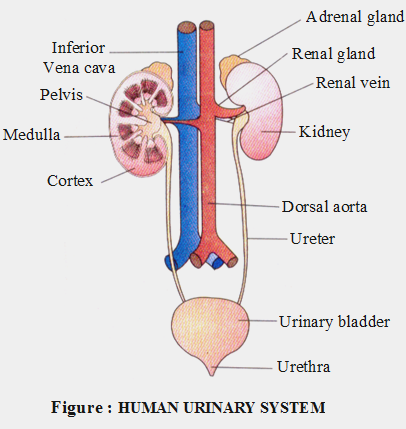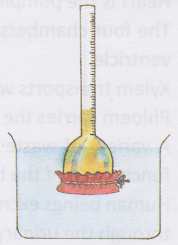Process of Excretion in Human Body
Excretion
There are a large number of chemical reactions that take place inside a living body. As a result, a variety of waste products are constantly being generated. The living body needs to remove these wastes. Excretion is the elimination of metabolic waste products from the body. The process of removal of wastes from the cells of living organisms is called excretion. The organ system responsible for the removal of wastes is called the excretory system.
Waste Products
- Nitrogenous Waste Products. They are the major waste products which are formed during breakdown of extra amino acids, nucleic acids and alkaloids. The important nitrogenous waste products are urea, uric acid, creatine, creatinine and ammonia.
- Non-nitrogenous Waste Products – Oxalic acid, lactic acid.
- Excess Chemicals – Excess minerals, drugs, pigments, vitamins, hormones, cholesterol, etc.
- Bile Pigments – Bilirubin, biliverdin and urochrome.
- CO2
- Excess water.
Read More: Process of Excretion in Plants
Excretion in Animals
Animal wastes mainly include carbon dioxide (that is formed during respiration), wastes of the digestive system, and other wastes such as urea and uric acid. Animals such as Amoeba, Paramoecium, Hydra, etc., do not have a well-developed excretory system. They get rid of all kinds of body wastes by direct diffusion through the cell membranes. Animals such as earthworms, insects, and leeches have tubular structures that help to get rid of body wastes.
Excretion in Human Being
The human body excretes wastes in the following ways:
Through exhaled air Carbon dioxide, formed after respiration, is sent out of the body with the exhaled air.
Through sweat Our skin also acts as an excretory organ. It has small outer openings called sweat pores.
Our body gets rid of a small quantity of urea, salts, and water through sweat secreted by the sweat glands present under the skin. Sweating is important because it helps in regulating body temperature. It helps to keep the body cool by losing body heat, as sweat evaporates off the skin.
Through the kidney A number of nitrogenous wastes such as urea and uric acid are formed inside our body. Urea is a result of the combination of carbon dioxide and ammonia. It is excreted from the body in the form of a pale yellowish-coloured liquid called urine. Urine contains almost 95% water and the remaining 5% consists of urea, uric acid, and minerals.
Formation of urine takes place inside the kidneys. A pair of kidney is the main excretory organ in human.
Structure and Function of Kidney in Human :
The human excretory system comprises
- A pair of reddish, bean-shaped organs called kidneys,
- Two tubes called ureters,
- A urinary bladder that stores urine, and
- A urethra that removes the urine.
Waste substances present in the blood are removed with the help of the kidney. When blood enters the kidney, the useful substances are absorbed/filtered back into the blood. Waste substances get dissolved in water and are removed as urine. This absorption/ filtration is carried out by the functional unit of the kidneys called nephrons. Urine thus formed is collected via the ureters into the urinary bladder.
Then, urine is passed out from the body through the opening at the end of the urethra.
 Dialysis
Dialysis
Kidneys work in pairs, but they are so efficient that even if one gets damaged, the person can still lead a healthy life. In case both the kidneys are damaged, a person can survive with the help of (a) regular dialysis or (b) a kidney transplant.
Dialysis is a method for removing toxic substances from the blood with the help of a machine when the kidneys are unable to do so. The dialysis machine is also called an artificial kidney. Blood from an artery of the arm is led through the dialysis machine, where urea and excess salts are removed. The blood is then led back to the patient’s body through a vein. In a kidney transplant, at least one of the diseased kidneys is replaced with a healthy kidney from a donor.
Activity
Aim: To demonstrate how substances move through a semi-permeable membrane, as in dialysis
Materials needed: A thistle funnel, a beaker of water, sugar solution, a clamp stand, a piece of thread, and an egg membrane or cellophane paper
Method:
1. Take some concentrated sugar solution in the thistle funnel and cover the mouth of the funnel with the egg membrane and tie it with thread.

2. Invert this funnel arrangement in the beaker of water. Mark the level of sugar solution in the funnel.
Observation: The level of liquid in the thistle funnel will rise.
Conclusion: This is because the egg membrane is semi-permeable and allows only the solvent molecules to pass from its higher concentration (water in the beaker) to its lower concentration (in the thistle funnel). It does not allow molecules of the solute to pass through. This is exactly how solvent molecules move in dialysis.
